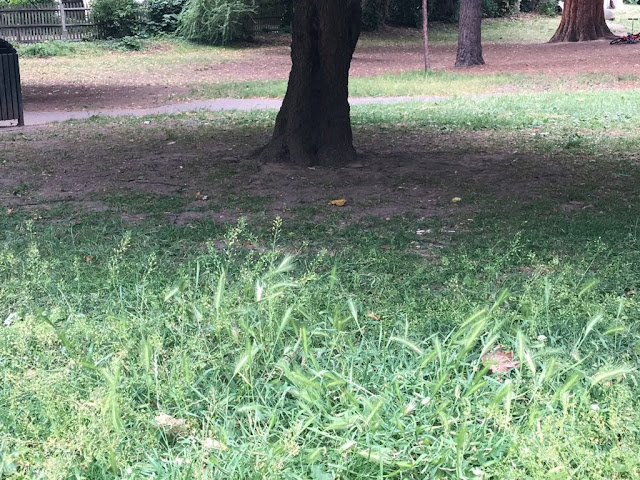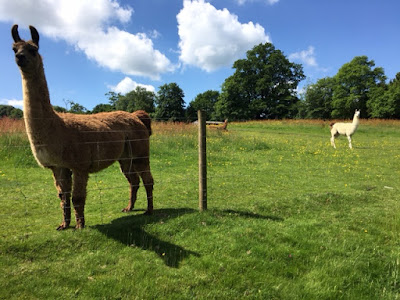It may look innocuous, you may even think that wild look pretty, but I have suffered the effects of getting grass seed in my ear twice. It is nasty, and it can happen very easily if you have cocker spaniel dangly ears like me and like to run in the grass and sniff around trees. This is usually where that nasty stuff grows and, as anyone with a dog knows, this is the first place a dog off-lead will head.
It looks like an arrow head and, once in the ear, makes me and other dogs, shake their heads non-stop. It's not only annoying, it's painful and dangerous. I had to be sedated (dangerous in itself, and costly) by my vet in order to have this removed, as, once anywhere in the body, it will try to make its way out causing all sorts of havoc.
Last year, my local council (Ealing) thought it a great idea to cut less grass in all of the borough's parks, in order to save money, or let wildlife thrive (I know which I believe. If they really wanted to attract bees and help nature they would plant lavender, which smells and looks divine and won't harbour ticks either!!!). What happens is they cut only by the footpath edges, not anywhere near or around the base of the trees, or, if there is a group of trees, anywhere in that vicinity.
My human (bless) bombarded the council with emails and letters, put up posters to warn others of the danger of grass seed, but got little response until 3 months, and several letters and emails later, other to say this will be their policy for the next 5 years...
So, here we are, another year, and the same policy. If only they would leave just one of the borough's parks (they are parks, after all, not meadows, or woodlands) well kept and the grass cut short, so that I, and all my fur friends, could run off-lead without facing this hazard. It is also a pity that the little humans have very few nice patches of grass to picnic on during summer months. Grrrrr!!!
To cheer me up after this rant, my human has promised to take me to Windsor where, hopefully, I can run off-lead on the Long Walk, and avoid this stuff. In fact, we have gone on days out ( you know, further afield - get it? woof!!) simply so that I can avoid it, so perhaps there's the silver lining. We will let you know how Windsor fared. For now, here's some information taken from the Kennel club website on grass seed injuries to dogs.
Grass seeds
injuries
Dogs with injuries
caused by grass seeds is an extremely common seasonal and painful
problem.
Where do grass
seeds commonly affect dogs?
The two most common
presentations of a dog with a grass seed are the foot and the ear,
although other places on your dog's body can be at risk too. Grass
seeds commonly get in between the toes of the dog's foot, referred to
as the inter-digital space. The grass seed already attached to the
surrounding soft feathery fur now makes its way towards the foot
itself, penetrating with ease the thin skin before starting to burrow
deep into - and through - highly sensitive tissues of the foot
resulting in extreme pain, discomfort, infection and sudden onset
(acute) lameness.
The second most
common place for these seeds to cause problems is down the ear canal,
their uni-directional nature and shape allows the grass seed to work
its way from the fur around the ears down along the ear canal, and
come to rest right up against the delicate ear drum.
Your dog may shake
its head and vigorously lick its paws. They may also look
uncomfortable, lethargic and in a lot of pain. If you notice any of
the above signs, especially head-shaking, paw-licking or any other
abnormality - then call your vet straight away for the most
successful treatment outcomes. Finally, please help to raise
awareness and tell others, especially first-time dog owners, of the
symptoms to look out for, as a tiny little grass seed can often be
the cause of one of the most painful, expensive, and common
conditions our beloved dogs can suffer from.
What treatment is
available for dogs that have been affected by grass seeds?
As grass seeds are
made from vegetable matter they're invisible on x-ray (unlike bone or
metal) so their exact location within the paw is usually a mystery.
Sometimes a second hole is detected where the grass seed has already
travelled through the entire foot and exited through the other side
leaving a narrow empty tunnel, or 'sinus', connecting the two.
If it is the ear
that is affected, your vet may examine the ear to confirm the
diagnosis and remove the grass seed with tweezers. Your vet may
prefer to sedate your dog as they may be in too much pain to allow
your vet to examine and for safe removal.












































